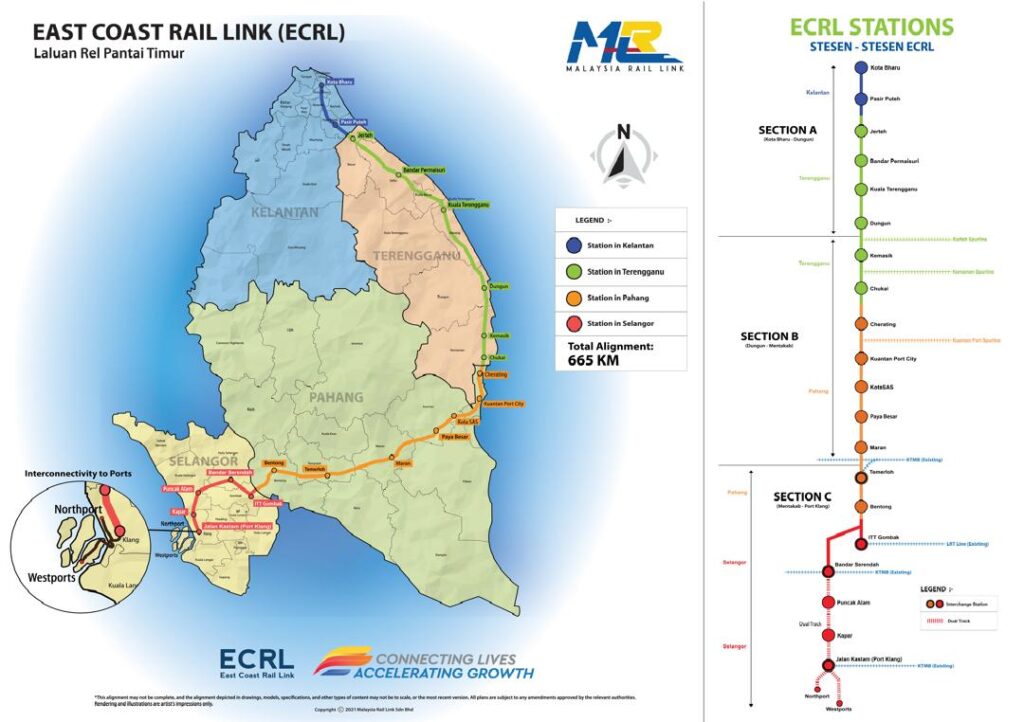
By Shadow Pine
In Malaysia’s ambitious quest to bridge its east and west coasts, the East Coast Rail Link (ECRL) was envisioned as a golden lifeline, a shimmering conduit of economic promise. Will this vision shift to a more realistic realm, considering the ongoing global trade tensions?
This 665-km railway, a flagship of China’s Belt and Road Initiative, held the tantalizing prospect of transforming Malaysia into a regional trade hub. Plans could have included how “Made in China” goods, rolling through its sleek carriages, may emerge on the west coast stamped “Made in Malaysia,” sidestepping hefty U.S. tariffs on Chinese imports.
Yet, as global trade winds shift and controversies swirl, the ECRL’s golden glow could be dimming to a resilient and more humbler bronze, just as questions are raised on its future in a tariff-laden world.
Ambitions for ECRL, among other, hinged on leveraging Malaysia’s strategic ports including to re-export China made goods with minimal value added, particularly to the U.S., evading tariffs as high as 125–145% on China. However, the U.S.’s recent imposition of a 24% tariff on Malaysian exports, temporarily reduced to 10% for 90 days as of April 2025, may have disrupted this. Coupled with rigorous U.S. scrutiny of Malaysian semiconductors and pharmaceuticals of Chinese origins, the reexporting strategy could lack the luster.
This shift comes amid heightened global attention on Malaysia’s economy, sparked by recent remarks from U.S. commentator Bill O’Reilly, a close acquaintance of President Trump. During Chinese President Xi Jinping’s Southeast Asia tour in April 2025, O’Reilly dismissed Malaysia’s economic significance, stating, “The Malaysians aren’t gonna buy your stuff. They don’t have any money.” His comments ignited backlash across Malaysia, with netizens and officials highlighting the nation’s robust economic indicators: a GDP growth of 5.1% in Q4 2024, a trade volume with China reaching RM41.43 billion in January 2025, and a gross national income per capita of RM54,894. While O’Reilly’s remarks were meant to question China’s regional trade strategy, they overlooked Malaysia’s resilience and its deepening ties with China, exemplified by 31 new trade and infrastructure agreements signed during Xi’s visit.
Far from being a sign of weakness, the ECRL’s pivot from a golden dream to a bronze reality reflects Malaysia’s required adaptability. The rail’s core mission, enhancing domestic connectivity and regional trade, remains vibrant. By linking Malaysia’s less-developed east coast to its industrial west, the ECRL promises to uplift local economies, even if domestic demand is still nascent. Regionally, plans to integrate the rail with networks in Laos and Thailand underscore its potential as an ASEAN trade artery, bolstered by China’s unwavering investment. Malaysia’s trade with China, which accounts for 17.1% of its total trade, continues to thrive, with 61% of its 2022 e-commerce transactions tied to Chinese platforms like Taobao and AliExpress.
However, challenges loom. The ECRL’s $10 billion price tag, largely financed by Chinese loans, weighs heavily on Malaysia, especially as U.S. tariffs potentially threaten reexport revenues. If the 24% tariff is reinstated in July 2025, sectors like semiconductors (37% of Malaysia’s medical device exports go to the U.S.) could falter, straining funds for infrastructure. Additionally, the east coast’s limited industrial base may leave the rail underutilized, hauling less cargo than that envisioned earlier. Malaysia’s growing reliance on China, while strategic, also risks over-dependence in a volatile global economy.
Yet Malaysia is no stranger to navigating complex waters. The nation is actively engaging the U.S. to secure tariff relief while strengthening ties with ASEAN and China. Prime Minister Anwar Ibrahim’s diplomacy during Xi’s visit reaffirmed Malaysia’s role as a dynamic partner, not a bystander in global trade. Despite the setback, the ECRL, shines as a symbol of Malaysia’s resilience, poised to connect communities and drive regional growth.
As the world watches Malaysia’s next steps, the ECRL’s story is one of transformation, not defeat. It reminds us that even when golden dreams fade, a bronze reality, forged in adaptability and ambition, can still pave the way to a prosperous future. Let’s celebrate Malaysia’s economic vitality and its bold vision, proving skeptics wrong with every mile of track laid.

Shadow Pine is an independent investigative journalist dedicated to uncovering hidden truths, especially in high-stakes and controversial matters. Operating discreetly to protect sources and maintain integrity, Shadow Pine focuses on stories that others might shy away from, aiming to bring clarity and accountability to the forefront for the well being of the nation.